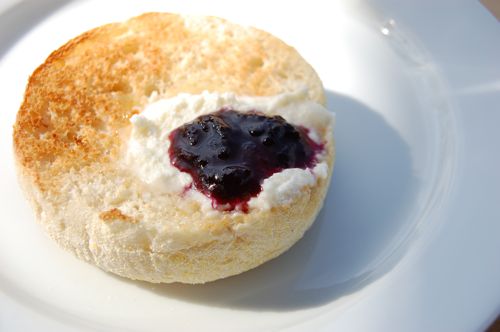Muffin of the gods

My dairy snipe hunt on Friday yielded an unexpected benefit. At the top of my half-gallon of local (unhomogenized) milk was an inch-thick plug of clotted cream. And if you don’t know what that is, well…that’s a shame.
Back in Devonshire, where I had the great privilege of attending school for a year of my life, they’re famous for a thick, farm cream the consistency of mud. This they spread over scones and top with jam, and eat until they pitch over backwards in a blissful, butterfat-induced coma. I’ve even eaten ice cream made out of the stuff, a butterfat indulgence that exceeded anything I’d ever experienced, at least until the debut of so-called “super premium” ice creams. Good as they are, though, these fat bombs still don’t possess the same subtlety of flavor as the clotted stuff right off the farm.
How is clotted cream made? I’ve seen it done, and it involves heating slightly soured cream in broad, shallow pans over a low flame. The heat softens the fat globules in the cream, causing them to congeal into a 60% butterfat bonanza.
A similar effect can be achieved by pasteurizing unhomogenized milk. The heat softens the membranes around the fat blobs that are suspended in the milk, causing them to join together. They then rise to the surface (actually, that’s a bit of a misnomer, fat doesn’t so much rise as water sinks, being so much heavier). The result, when the bottle of milk is chilled — if you’re lucky — is a semi-firm mass just under the lid.
I confess it took me a while to work that spackle-like gold out of the bottle with a spoon. My daughters had no idea what was wrong with daddy as I performed surgery on the bottle, a mad gleam in my eye. But oh my brothers and sisters, was it ever worth it. Slathering it over a nice thick English muffin, I was transported right back to Devon.